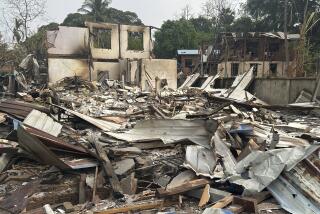Some Indian Towns Reject Mexico Rebels
- Share via
SAN CRISTOBAL DE LAS CASAS, Mexico — When Mexican troops marched into Chanal, the last rebel-held town, last week after overcoming a token defense by Indian guerrillas on the outskirts, villagers proudly handed them 14 rebels.
The soldiers were not surprised.
Residents of San Juan Chamula had also turned over a captured guerrilla to the government, and in Oxchuc citizens had pleaded with the army to come get 14 rebels they had captured--and allegedly stoned.
All three Indian towns came down firmly on the side of the government and against the guerrillas, whose avowed purpose is to fight for the rights of indigenous people.
The government claims that their actions showed the lack of Indian support for the armed movement.
But researchers and human rights activists who know the area say reasons could range from fear of reprisals to a traditional conflict between the residents of county seats and the more impoverished rebels living in the hills surrounding them.
“The rebels are not all of the Indians, or even a majority,” said Richard Nye, an anthropologist who has lived in the area for 24 years.
“Those participating in the movement are the most radical line of one position taken by the Indians: The only way to force political change is revolution,” he said. “This has not been accepted by a majority, although all are sympathetic to their demands.”
Although other Indian groups may be sympathetic, they are not willing to risk their own communities for a group of strangers, said Susanna Paisley, development coordinator at Casa Na Bolom, a research center here for Indian cultures.
“The Chamula asked for federal troops to come guard their city so there wouldn’t be any question about what side they are on,” said Will Hoffman, cultural projects coordinator at Na Bolom. “They know what could happen if they get caught in the middle.”
An Interior Ministry report released Friday repeats the government’s insistence that peasants were pressured into participating and that the rebels have little grass-roots support. And President Carlos Salinas de Gortari has said he will consider pardons for peasants who were tricked into joining the rebels.
“Peasant recruits have told us that there have been cases where children were taken hostage to gain their parents’ participation,” the report stated. Others were said to have been threatened with expulsion from their communities if they did not participate.
The strongest rejection of the guerrillas was in Oxchuc, where captured rebels told reporters that they were stoned and beaten.
“They burned our buildings,” one villager, a heavyset man who would not reveal his name, explained as he gestured toward the gutted frames of modest concrete-block buildings that were once municipal offices.
Oxchuc residents were shocked that international media had portrayed them as savages for their treatment of the prisoners. The day after the incident, Oxchuc leaders were on the second floor of the village gazebo, watching for reporters and telling residents over the public address system not to talk with them.
Officials from half a dozen Indian communities attended a news conference apparently staged by the government to express their opposition to the guerrillas.
And many villagers did not blame the Salinas administration for failing to send immediate help when they were under siege.
“We understand that our government has limited resources,” one Oxchuc leader said. “The problem is you foreigners who come here bringing trouble.”
So it came as little surprise that local leaders decided to turn in the guerrillas, who are mainly from the hillsides, one rights activist said.
“People in the county seats are more or less contented and accepting of their lot,” he said. “It is in the outlying areas that conditions are most extreme.”
Bases are in remote areas that can be reached only after three- or four-hour journeys over hidden trails through dense vegetation.
It is in these remote areas that the guerrillas have actively recruited, according to government reports. And that is where their support runs deep.
In the guerrilla strongholds, women, old people and children provide support systems from food and money to transporting arms and providing lookouts.
“The group gradually transforms the dynamics of communities under their control,” the government report stated. “All productive activity is practically paralyzed, and municipal activities, including education, are neglected.”
More to Read
Sign up for Essential California
The most important California stories and recommendations in your inbox every morning.
You may occasionally receive promotional content from the Los Angeles Times.













